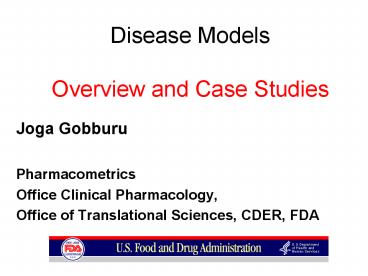Disease Models Overview and Case Studies - PowerPoint PPT Presentation
1 / 23
Title:
Disease Models Overview and Case Studies
Description:
Between 2000-2006, 72 NDAs needed Pharmacometrics Reviews/Analyses ... Cmt 1. Cmt 2. 1st order Oral Absorption. FPG-HbA1c relationship. from historic studies ... – PowerPoint PPT presentation
Number of Views:165
Avg rating:3.0/5.0
Title: Disease Models Overview and Case Studies
1
Disease ModelsOverview and Case Studies
- Joga Gobburu
- Pharmacometrics
- Office Clinical Pharmacology,
- Office of Translational Sciences, CDER, FDA
2
Pharmacometrics Survey
- Between 2000-2006, 72 NDAs needed Pharmacometrics
Reviews/Analyses - For each of the Pharmacometrics Reviews, the
customers were asked to rate the impact on
approval related and labeling decisions - Pivotal Decision would not have been the same
without Pharmacometrics analysis - Supportive Decision was well supported by the
Pharmacometrics analysis - No Contribution No need for the Pharmacometrics
analysis
3
Impact of Pharmacometrics Analyses 2000-2004
Pivotal Regulatory decision will not be the same
without PM reviewSupportive Regulatory decision
is supported by PM review
Bhattaram et al. AAPS Journal.
2005 7(3) Article 51. DOI 10.1208/aapsj070351
4
Pivotal Regulatory decision will not be the same
without PM reviewSupportive Regulatory decision
is supported by PM review
Impact of Pharmacometrics Analyses 2005-2006
DCPDivision of Clinical Pharmacology _at_survey
pending in 1 case
5
NDA1 Approval of monotherapy oxcarbazepine in
pediatrics for treating partial seizures using
prior clinical data
- FDA/Sponsor pursued approaches to best
- utilize knowledge from the previous trials to
- assess if monotherapy in pediatrics can
- be approved without new controlled trials
6
NDA2 Establishment of biomarker-outcome
relationship allowed more efficient future trial
design
- The sponsor was pursuing an accelerated approval,
for drug to prevent a life-threatening disease,
based on a biomarker even though clinical
endpoint analysis failed in two pivotal trials
7
NDA2 Establishment of biomarker-outcome
relationship allowed more efficient future trial
design
Relative risk of the disease event
Hazard ratio10.0 (95 CI 2.5-30.0) pRatio of biomarker level to baseline
8
NDA3 Insights into trial failure reasons will
lead to more efficient future trials
Severe Baseline Disease Responders
Mild Baseline Disease Non-Responders
9
Females seem to be more sensitive to QT
prolongation
Slope
Slope
Slope
Slope
10
Need/Opportunities for Innovative Quantitative
Methods in Drug Development
Optimal design to show disease modifying
effects?
Good marker(s) of survival benefit in cancer
patients?
Maximize the change of success of a 2yr obesity
trial?
Given 85 of depression trials fail, how to
improve success?
Best dose for a 26wk trial based on 12 wk data?
Providing solutions for these issues calls for
efficient use of prior knowledge
11
Manage and Leverage Knowledge
Information
- Biomarker-Endpoint
- Time course
- Drop-out
- Inclusion/Exclusion
- criteria (Trial)
Placebo Disease Models
- Parkinsons
- Obesity, Diabetes
- Tumor-Survival
- Rheumatologic condition
- HIV
- Epilepsy
- Pain
Knowledge
We are referring to such diverse quantitative
approach(es) as Disease Modeling
12
Core Development Strategy for Testosterone
Suppressants
IC50
Reporter Gene Assay
- Early screening of compounds based on IC50
value. - High thrput method to filter thousands
of compounds - Based on prior experience, a few
potential entities will be selected for the next
phase
Preclinical
PKPD data
Disease Model
- In vitro IC50 as a guide for preclinical dose
selection - Animal models to measure all
possible biomarkers e.g. GnRH, LH, T and Drug
conc.
Clinical Trial Simulation
Dose optimization in cancer patients
PKPD data
- Invitro and preclinical data for clinical dose
and regimen selection - Clinical development plan
- Pilot study for dose optimization thr
innovative trial designs
Pivotal trial
----2 mo-----
----2 mo-----
----2 mo-----
----3 mo-----
---------12 mo--------------
Actual execution time.- it does account for time
spent accumulating resources.
From Pravin Jadhav, VCU/FDA
13
Obesity
- Obesity trials are large, over 1-2 yrs and
fraught with challenges due to high drop-out rate
Dr. Jenny J Zheng Dr. Wei Qiu Dr. Hae Young Ahn
14
Obesity
Model Qualification
Baseline Body Weight 3000 patients
15
Patients with small weight loss drop-out
Drop-out patients
Remaining patients
0-12
36-52
12-24
24-36
16
Obesity Time Course of Placebo Effect
17
Value to Drug Development
- Effective use of prior data for designing future
registration trials - Might lead to alternative dosing considerations
- Titration vs. fixed dose
- Could lead to increased trial success
- Allows of designing useful shorter duration
trials for future compounds for screening and
initial dose range selection
18
Diabetes
- How to reliably select doses for registration
trials based on abbreviated dose finding trials - Need arose from an EOP2A meeting
- Work in progress No patient population and
drop-out models yet.
Drs. Vaidyanathan, Ahn, Yim, Zheng, Wang,
Gobburu, Powell, Sahlroot, Orloff
19
Pivotal Trial Dose Selection Anti-Diabetic
- Sponsor conducted 12 wk dose ranging trial in
diabetics - Key Regulatory Question
- What is a reasonable dose range and regimen for
the pivotal trial(s)? - Challenge
- Estimate of effect size on HbA1c at 26 wks not
available. Effect size on FPG available.
20
FPG-HbA1c relationship from historic
studies employed to estimate effects on HbA1c of
the new compound
Drug Conc.
FPG
HbAlc
Time (Week)
Jusko et al
21
Biological relationship between FPG-HbA1c bridged
information gap
Drug X (other) in 28 patients
Hybrid dataset in 100 patients
Drug X (Sponsor) in 72 patients
22
Value to Drug Development
- More informed dose/regimen selection
- Could lead to increased trial success
- Quantitative analysis was critical
- Effective use of prior data for predictions
- Supports conduct of useful shorter duration
trials for future compounds
23
Disease Models Challenges
- Data Management
- How to best maintain an efficient database?
- Analysis
- How to best conduct meta-analysis?
- Identify and fill gaps (time-varying biomarkers
in survival models)? - Inter-disciplinary collaboration
- Biologists, Pharmacologists, Statisticians,
Disease Experts, Quantitative Clinical
Pharmacologists, Engineers need to come together
to develop these models as a team.































